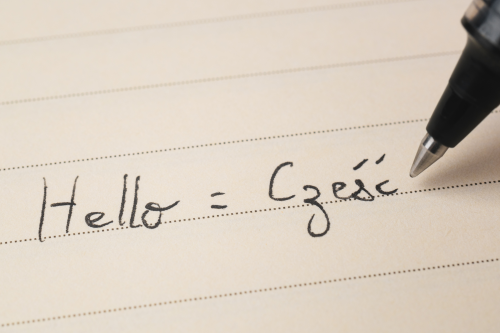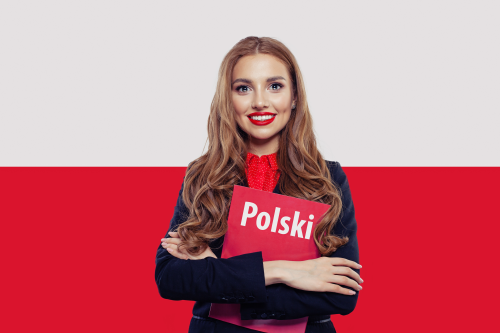
Are you learning Polish, or maybe you want to impress a Polish friend? Polish greetings are vast, but you don’t need to know them all, and just a handful will suffice for most situations. Just make sure that the ones you pick cover both informal and formal greetings.
Even though most, especially young people, will understand common English greetings, greeting others in their native language is a great conversation starter. Below, we present our selection of the most common greeting phrases in the Polish language. Enjoy!
Spis treści:
Common informal greetings in Polish
Let’s start off with the most common greetings that Poles use in everyday informal situations.
“Hi” or “Hello” in Polish
A Polish equivalent of “hi” and “hello” is the word cześć. The first phrase and it’s already packed with strange symbols. The word is pronounced something like chech-sh-ch. It isn’t exactly the correct pronunciation, but it will be good enough. It’s a very frequently used informal greeting that is mostly used by friends, family members, or at least people you have already met earlier. Moreover, cześć isn’t just a greeting and can be used to say “bye” when you are ready to head off.
Witaj – “Welcome”, is a tad bit more serious greeting with similar meaning. If you struggle with pronouncing cześć, use this one. It’s pronounced roughly as vitay.
“Hey” and “What’s up” in Polish
Hej, although it sounds just like English “hey”, is used more as an equivalent of “hi”. The pronunciation shouldn’t pose any problems.
Likely the most informal greeting used only among close friends is siema. It’s a laid-back Polish word similar to the English phrase “what’s up”. Siema is a contraction of jak się masz? – “how do you do?”, “how are you?”.
“How are you” in Polish
To say “How are you?”, you can use mentioned jak się masz?, but there is also a more friendly phrase co słychać?. A literal translation would go something like “what are you hearing”. Just treat it as “what’s new?” or “how is it hanging?”. Another option is to use the more colloquial jak tam? or jak leci? – similar meaning.



Formal greetings in Polish
You might find formal greetings in Polish more approachable, as just two phrases will fit almost all formal situations.
“Good morning”/”good afternoon”/”good evening” in Polish
There’s just one formal greeting for these in Polish, and it’s dzień dobry. When in doubt, just use this one no matter the time of day. It literally means “good day”, and is a one-type-fits-all formal greeting. A customary addition to Polish greetings is to shake hands. Greeting people in such a way is common in a professional context when first meeting people and exchanging names, or just among male friends. In friendly relations, women more often hug or kiss on the right cheek. The latter is also a traditional way to greet people of both sexes in a close family. When parting ways or concluding a meeting, you should use do widzenia, an equivalent of “goodbye”, although the literal translation would be closer to “see you later”.
If you are feeling particularly ambitious you could also learn dobry wieczór (“good evening”), however, no one will bat an eye if you just say dzień dobry even when it’s late.
Other ways to greet people
If one would want to go a step further in showing respect, one could use the aforementioned witam in a phrase such witam pana (“welcome sir”) or witam panią (“welcome lady/madame”). In English, these may seem overly old-fashioned, but in Polish, it is very common to use the forms Pan/Pani when you address people whom you are not familiar with, your superior or people older than you.



How to say “goodbye” in Polish
There are of course the two mentioned phrases cześć and do widzenia. They work great in most cases. Additionally, there should also be included dobranoc (“good night”) to use at night. On top of that, in informal relations, Poles also use na razie (shortened to nara by young people) and do zobaczenia.
Other useful Polish words
Other than learning ways to greet people, knowing at least a few key Polish vocabularies might be a practical idea. Take a look below!
“Please” in Polish
“Please” in Polish is proszę and is pronounced prosheh.
“Thank you” in Polish
The Polish word for “thank you” is dziękuję. The rough pronunciation: jen-koo-yeh.
“Yes” and “No” in Polish
“Yes” in Polish is tak (tahk) and “no” is nie (nyeh).
“Good” and “Bad” in Polish
These two basic adjectives in Polish are, respectively, dobry (doh-bri) and zły (zwi).
Languages are great and we know it
We hope that you found this article interesting and that you learn all you needed to know about how to greet people in the Polish language. These won’t make you speak Polish like a native speaker, but will surely turn out useful when visiting Poland and help you make a good first impression on many Poles. Learning a new foreign language is a great idea, and if you want to learn Polish or improve your Polish pronunciation, you should find our offer interesting.
We offer courses for both companies and private clients in a wide range of languages including Polish, but also English, Spanish, French, or German, just to name a few. Classes can be held on-site or online – we offer e-learning using a special educational platform. Additionally, our company has a wide and complex offer of translation services in many languages. All the information can be found on our websites. Everything neatly tailored to your language needs!

